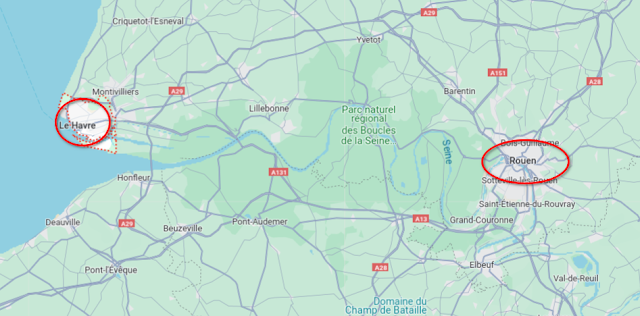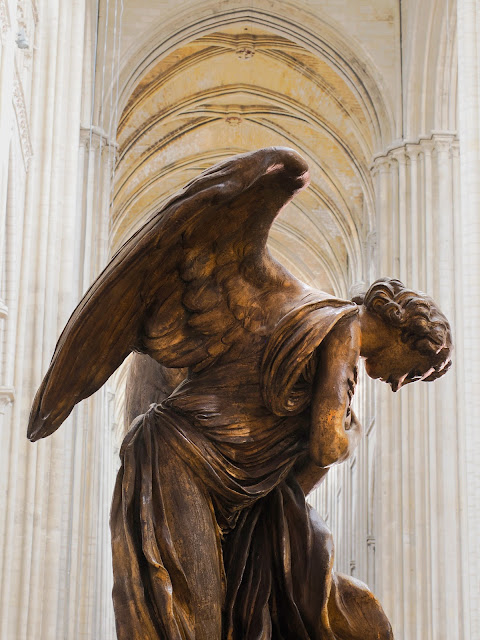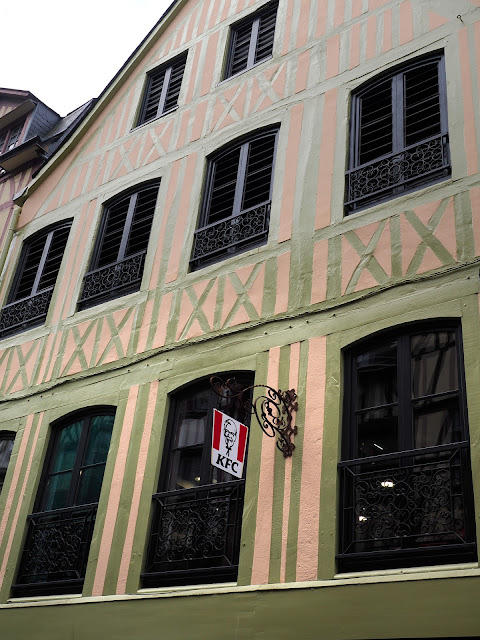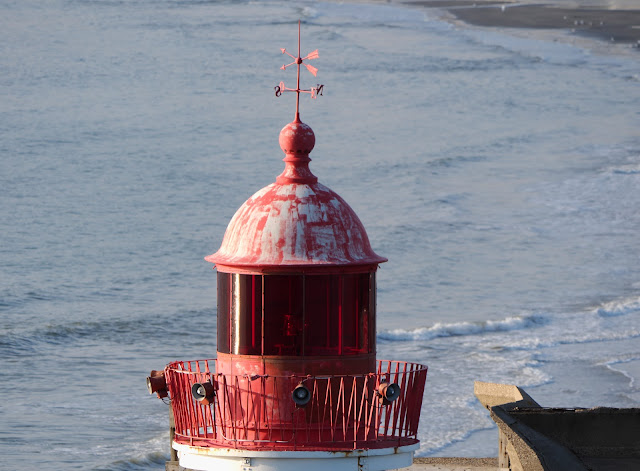
We docked in the port city of LeHavre, France, which handles 1.5
million containers a year. It's located at the mouth of the Seine river,
about two hours by car from Paris.
Le Havre was flattened by the Germans in WWII, and was almost totally rebuilt. Most of the new construction was done with concrete, for speed and cost savings. It's a very industrial city, and it's main industries are shipping, petroleum refining, and plastics.
 |
| A large sculpture of shipping containers graces a park at the entrance to the terminal. Tres Chic! |
|
|
 |
The new concrete city center
|
 |
Our French port crew hard at work
|
 |
A little leisure in the harbor
|

 |
The pilot boat
|
Rouen
 |
The road was lined with fields of Canola, giving a striking yellow touch to the landscape
|
Our field trip to Rouen was primarily to tour the Cathedral, which was started in 1030 AD, and finished in 1880. It's one of the earliest gothic cathedrals, featuring one of the first uses of the flying buttress. The outside is very ornately carved stone. Prior to the 20th century, the church sustained heavy damage during a number of wars, a hurricane, and lightning strike.
20th century (from Wikipedia):
"At the beginning of World War II in 1939, remembering the damage
caused to French cathedrals in World War I, the Cathedral authorities
protected the sculpture of the cathedral with sandbags and removed the
old stained glass and transported it to sites far from the city. Nonetheless, in the weeks before D-Day in Normandy, the cathedral was hit twice by Allied bombs. In April 1944, seven bombs dropped by the British Royal Air Force
hit the building, narrowly missing a key pillar of the lantern tower,
and damaging much of the south aisle and destroying two windows. In
June 1944, a few days before D-Day, bombs dropped by the U.S. Army Air Force set fire to the Saint-Romain tower. The bells melted, leaving molten remains on the floor.
Following World War II, a major restoration effort began to
repair war damage by the Service of Historic Monuments, concluding in
1956. Then a new campaign began to consolidate the structure and to
restore the statuary of the west front, including putting back four
statues that had been moved elsewhere. In 2016, the project was
finished and the scaffolding which had covered much of the cathedral for
a half-century was finally removed.











Around the cathedral is a walking street with a lot of old buildings from the 14th, 15th, 16th,17th and 18th centuries. I'm not sure what the French call the style, but it reminds me of the Tudor style I've seen in England. Oak and Chestnut timber combined with masonry infills and either slate or Chestnut shingles.
 |
The house where Julia Child learned French Cuisine
|
 |
Probably not where Colonel Saunders learned to fry chicken
|

 |
A clock with only an hour hand, because who really cared about minutes way back then?
|
 |
No stone left uncarved
|
 |
Several centuries of joinery. If in doubt, add more fasteners
|
 |
Say, has anyone seen my tri-square about?
|
Back at LeHavre- some of the many hundreds of wind turbine blades being readied for an offshore energy project that is replacing a decommissioned power plant in the city.











































Rouen is one of my favorite French Cities...I loved it and still long to return. Loved the shipping container sculpture and the Cathedral is one of the World's best.
ReplyDeleteI am not technologically savvy enough to comment with my name attached but want to note on behalf of the French Carpenters Union that the problem appears less to be square, which would address competence, and more to be whether the door is plumb, which could be a vitamin B12 issue. ( _.. ._ ..._ . )
ReplyDelete